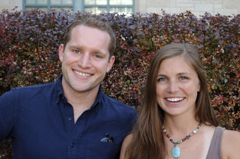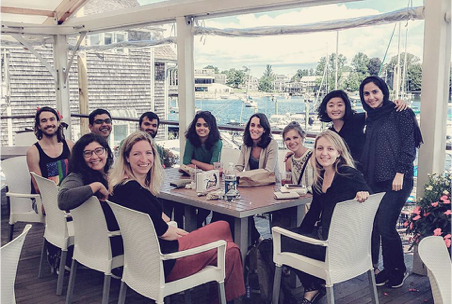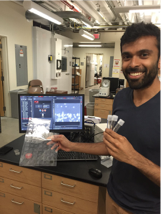MBL Summer Course Report
The Marine Biological Laboratory (MBL) in Woods Hole, MA is home to renowned graduate-level courses spanning the biological sciences. This summer, ESAM students Lionel Fiske and Brita Schneiders were students in two such courses, and Professor Madhav Mani served as course faculty, with assistance from ESAM alumnus Karna Gowda.
Here Lionel, Brita, and Karna share their experiences, and their advice for interested students.
Lionel participated in the second-ever Physical Biology of the Cell course run by Rob Phillips and Hernan Garcia, co-authors the widely read textbook of the same name. The three-week course focused the application of physics to studying cell biology.
What did you do as a student in the course?
The course was split into three parts: daily colloquia, lectures, and research rotations.
The daily colloquia—research talks given by invited speakers—exposed me to many points of view and approaches to modeling in biology. These talks were on about cutting-edge areas of research and often employed new experimental techniques to gather evidence for their models. The morning lectures not only helped me understand the problems that biologists are currently interested in, but also exposed me to novel approaches to solving them. After the talk, all but the students and speaker left the room to privately discuss topics ranging from research methods to personal philosophy. These sessions allowed us to have more candid conversations with these scientists, who often discussed the struggles they have faced over the course of their careers.
After the morning colloquia there were daily lessons that covered a number of topics across physical biology. The lectures focused mainly on applications of statistical mechanics and dynamical systems to cell biology, with topics of current interest to cell biologists such as gene regulation, liquid-liquid phase separation, and chemical oscillators. These lessons were intended to form a broad base of knowledge which we would draw on later in our final research project to build our own biophysical model.
Evenings in the first week centered on rotations in which experimental data was gathered to be used in the lectures in the following weeks. The first experiment used genetically engineered E. coli to shed light on how gene transcription is regulated. The second involved growing microtubules in vitro and finding the distribution of microtubule lengths using image analysis, in order to infer the process by which the tubules grow. In the third rotation we constructed an optical trap and used Hooke's law to characterize the spring constant of the trap. These rotations were designed to show how physical approaches can be married with conventional experimental techniques in a way which can further both fields.
In the final two weeks of the course, we performed longer-term research projects. I helped to develop a model describing how an actively transported protein can form a chemical gradient across a cell without the need to create new proteins. I developed the model as the limit of a simple lattice model which described the dynamics of a randomly walking protein in several contexts. I am currently in contact with my rotation supervisor about using this model to describe a phenomenon in budding yeast.
What value did it bring to your scientific view going forward?
The course emphasized the dual roles of theory and experiment. With the current suite of tools available in both genetic engineering and imaging, we are able to create and visualize controlled experiments in vivo which can be used to understand and test theories like never before. To move biological theory forward there is need to be quantitative, and for theoretical biologists to work closely with experimentalists. This course really showed how experiment and theory can, and should, work together. I hope to use these ideas in my own research by incorporating new experimental protocols and imaging technology to test rigorous and general models for polarity across epithelial sheets.
Brita participated as a student in Methods in Computational Neuroscience, a four-week course that brings together theorists and experimentalists at the intersection of computation and neuroscience.
What did you do as a student in the course?
We had several lectures in the morning and afternoon. Over the course of the four weeks, we heard 31 faculty speak. In the first half of the course, which was more lecture heavy, we worked on problem sets related to material from the lectures. We then presented our solutions in groups. The course was comprised of 24 students; half theorists, half experimentalists, so these problem sets entailed a good mix of background neuroscience and theory. In the final two weeks, we worked on projects with the course faculty. This involved setting up and proposing projects, presenting the proposals, then working with TAs and faculty (often different people than those who helped develop the projects, since faculty rotate in and out), and finally presenting the results at the end of the course.
Working hard was interspersed with fun breaks. Group sports were common in my course, as were traditions like swimming late at night to see plankton bioluminescence, something I didn’t know about until I got there, and which quickly became a favorite. There is great seafood around, so roughly once a week I would grab a couple friends and go to town to eat a real seafood dinner. There are great running and biking trails, and beaches as well. Many faculty gave a lecture and then stayed for a week or so, so there were many opportunities to have a meal with them and pick their brains. Once a week we had dinner at the director’s house, where the TAs and directors cooked for us, and we took a break from working and spent time with students, faculty, and their families who were in town for the week.
What value did it bring to your scientific view going forward?
Computational neuroscience is much broader than I realized. The course exposed me to how much diversity there is in the field, even just on the computational side. One can model a single neuron, which requires biophysics, or one can model a network of thousands of neurons (or more, if you’re doing “whole brain” modeling). As a theorist, I thought I would mostly be learning neuroscience, but there was much theory to be learned as well.
Though I came into the course considering myself to be pretty applied, I quickly realized that my neuroscience knowledge is still pretty basic. However, I also realized that one has to strike a balance between consuming and creating knowledge. As a theorist in a field that is new to me, there will always be more to learn, so it is tempting to keep consuming without doing anything new. It is a big transition, and often a struggle, to start creating rather than only consuming. One of the biggest lessons I took from the course, in which you go from “drinking water from a firehose” with intensive coursework for three weeks to diving into a ten-day project (still with daily lectures), was to stop trying to understand everything before taking action, and to just work. You do not and cannot know everything, so just work with what you have, and maintain a balance of learning as you continue to create.
The course also made me realize that I really should work closer to the science. Though the group in the course was a biased sample, it was inspiring to see how many experimentalists really value theory, and are buying into theory to back up their work. And conversely, theorists respected the experiments, and this was reflected in their modeling work. Both sides came to learn each others' language. The field seems to be headed in a positive direction where the number of experimentalists seeking theory, and theorists wanting to ground their work in experiments, is growing.
Lastly, it was refreshing to see a group of people who were motivated to answer high-level questions about understanding how the brain works. It helped me look up from my tiny niche and see what other people are up to. People in the course were curious about what everyone else was working on, openly asked questions, and openly mused about why something works the way it does. It was not about who had published what or who worked with whom; there was a broader goal of doing good work and collectively gaining a better understanding of the brain. This was true of students and faculty alike. It makes for a spectacular environment in which to do science.
What advice would you give to students in ESAM who are considering such an experience?
I had been told that a course like this was pivotal in past students’ graduate careers. As high as the bar was set, however, I felt it was surpassed—the course was an incredible experience. I urge other students to seek out such an experience, if only to get out of our small research bubble and see how others approach research, to see how much bigger your research community is than you may realize, or to learn new reasons why your work matters to others.
Also, a side effect of this course is that you will make new friends. I simply hadn’t considered this before going. I came into the course ready to learn and get to know people from a networking-for-my-career perspective, so I was surprised by how many friendships I formed. This made it sad for all of us to leave each other at the end of the course. The silver lining to this is that you will continue to cross paths at future conferences (my group met up at the Society for Neuroscience conference in November to get lunch, see each other’s talks and posters, etc.). For me, this was the beginning of getting to know the people in my field, whom I might work with for a long time to come.
Karna served as a research facilitator in the Physical Biology of the Cell course.  Additionally, he attended the MBL Physiology course as a student in the summer of 2016.
Additionally, he attended the MBL Physiology course as a student in the summer of 2016.
What was your role in Physical Biology of the Cell?
I assisted Prof. Madhav Mani with a research project conducted with two students in the course. We algorithmically generated and evolved dynamical gene regulatory networks, and used the algorithm as a tool to study evolution as a process.
The students we worked with both came from wet labs, and were learning how to code throughout the course. We spent the first few days of the project guiding the students through the logic of the algorithm as it was posed in a 2004 paper by Francois and Hakim. The algorithm generates models (or "cells") of protein chemical kinetics, capturing effects like transcription, degradation, and protein-protein interactions. Cells are ranked against one another based on how well they perform a specified function. We wanted to generate simple oscillators with specified periods, so in our case models were ranked relative to one another using Fourier spectrum information. The "fittest" models propagate to a new iteration of the algorithm and are modified according to some prescribed mutation rules (e.g., rates are modified, interactions are introduced, proteins are deleted). This process almost always generates an oscillator (an example here). The stochasticity underlying the algorithm means that different model structures and different evolutionary trajectories converge on this same final behavior.
After the students felt at ease with reading and writing code, we put together the algorithm and then encouraged the students to treat it as if it was an experimental system. Haneul Yoo, a PhD student in Biochemistry & Molecular Biophysics at U. Chicago, characterized the different stages of the evolutionary process of the algorithm. She observed that oscillator evolution often exhibits two distinct phases: a stationary phase during which the average fitness of the evolved networks does not increase, and a growth phase during which oscillation ability improves rapidly. She characterized these phases and found evidence that they follow Ronald Fisher's "fundamental theorem of natural selection". Ginger Hunter, a postdoc at National Institute of Neurological Disorders and Stroke and a geneticist by training, treated the networks as organisms and performed "knockout experiments" to identify proteins in evolved networks that affected the oscillation behavior. Although by the end of the simulation, the networks were often composed of more than 50 equations, each representing the dynamics of a single protein, she found that typically only five of these equations were important to the oscillatory behavior. In all, I think it was a great learning experience, both for the students, and for Prof. Mani and me!
What are you working on now, and how did MBL courses affect your trajectory?
I took the MBL Physiology course in 2016, and that was my first exposure to experimental work. Despite my inexperience, I was encouraged to dive in and to try doing things for myself. It was an opportunity to dispel my misconceptions of what experimental work is about, and also to develop an appreciation for the role of experiments in pushing science forward. Though short (the course was 7 weeks long), the experience was formative, and it led me to my current position as a postdoc in Physics at the University of Illinois at Urbana-Champaign, where I am doing both experimental and theoretical work to understand how ecological communities of microbes function and evolve.
